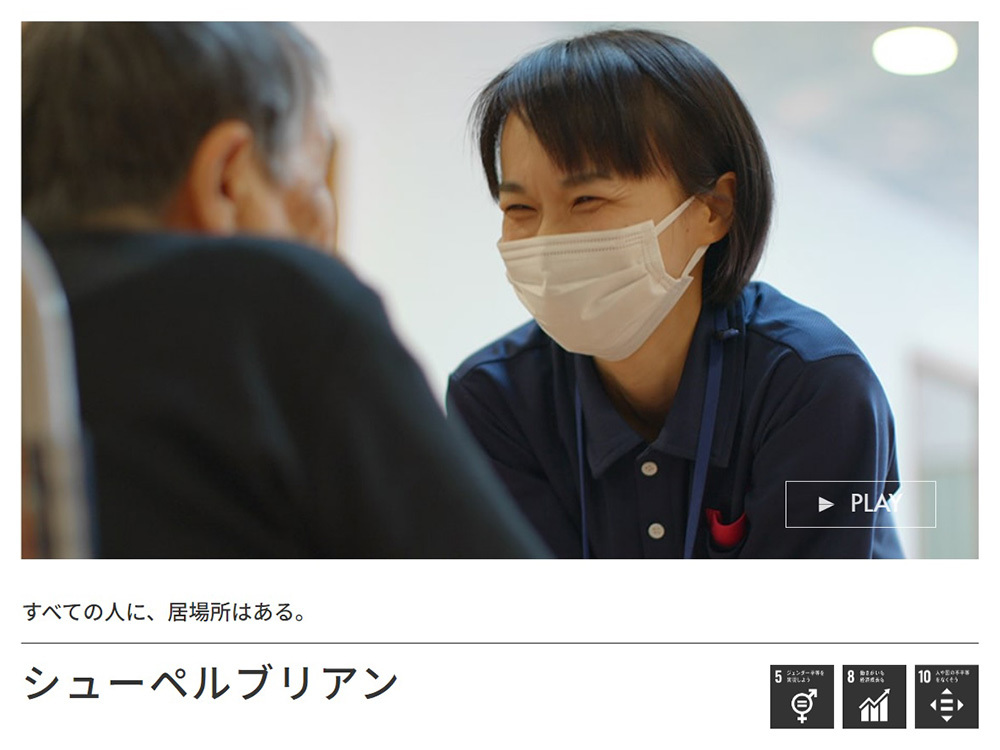Note: This website was automatically translated, so some terms or nuances may not be completely accurate.
What Future Do Small and Medium-Sized Enterprises Aim For? Let's Hear the Real Thoughts of Companies Starting SDG Initiatives
"Even with the SDGs, isn't it ultimately only large corporations that can take action?"
Profitability and business sustainability. When SMEs consider tackling the SDGs, actually getting started requires reevaluating existing operations and making various management decisions. To help regional SMEs confront these hurdles, identify achievable first steps, and support their SDG approach, regional banks, local media, and the Dentsu Group launched a co-creation SDG project. They established a platform where companies across regions can form "teams" to tackle the SDGs, and crucially, a platform for "communication" to engage and advance the initiative with many players.
Our previous article introduced the project's background, regional challenges, creative approaches, and hints for SMEs' unique SDGs strategies. This time, Dentsu Inc.'s Ikumi Tonosaki, who handled creative direction for the project, spoke with companies participating in Hiroshima and Fukuoka. They shared insights on the significance of SDGs engagement and discoveries made through their involvement.
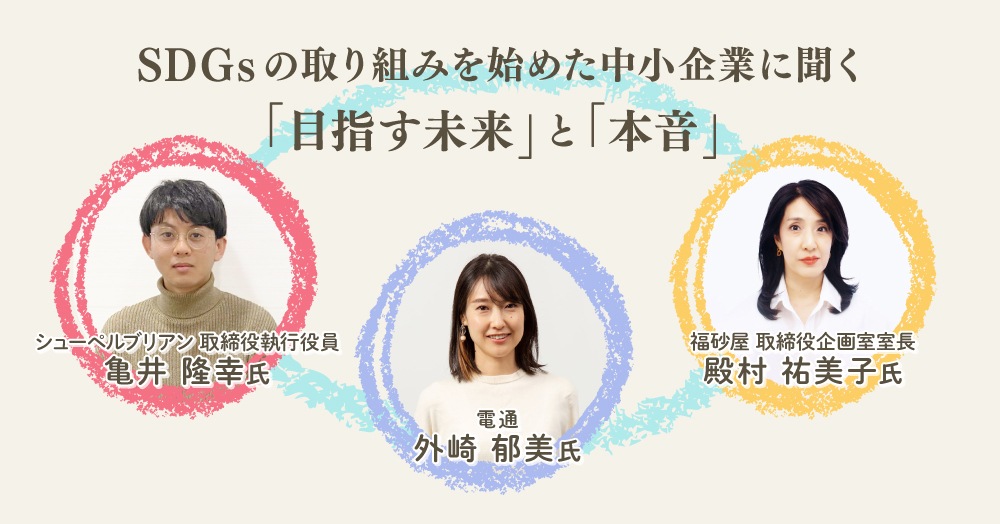
Continuing to make strides with a business model that contributes to society
Hiroshima-based Care and Human Resources Service Company "Superbrian"
Totsuki: First, we speak with Mr. Takayuki Kamei, Executive Officer and Director of Superbrian, who participated in the Hiroshima SDGs project under the slogan "Change is happening." Superbrian's business itself directly addresses challenges facing Japan today. Could you tell us again about your company's operations?
Kamei: Our company advances its business driven by the philosophy of our CEO, who seeks to solve social issues. For example, we provide employment support for people with disabilities and care services that support local communities, responding to societal needs as times change. We are also advancing digital transformation (DX) to address the challenges of a declining birthrate and aging population in new ways, enabling the provision of enriched care services.

Tozaki: While you've always pursued business that contributes to society, was there a specific moment when you became conscious of the SDGs?
Kamei: We realized that consciously applying the "SDGs" concept would allow us to more clearly address what society demands. We constantly consider how to create businesses that earn the appreciation, choice, and fundamental satisfaction of our local community members. This naturally leads our business ideas to focus on whether they "benefit society" or "contribute to solving social issues." Engaging with the SDGs presented an opportunity to think about what we could do within a framework defined on a global scale.
Togaki: For the "Changing Together" project, Hiroshima Bank helped align your company's business with specific SDG goals. Did you gain any insights from that process?
Kamei: Having our business objectively evaluated and scored was highly meaningful. It also allowed our employees to re-examine our own operations, helping align our perspective with society's. On the other hand, we truly felt the gap between our aspirations and our current reality. We particularly felt the challenge in Goal 5: "Achieve gender equality." It made us realize how entrenched we are in a male-dominated society and helped us recognize the actual state of our company. This led us to consciously work on actively hiring women and placing them in new positions.
Tozaki: That's an area many companies find challenging. Were there other goals directly relevant to your business?
Kamei: Goal 11, "Sustainable Cities and Communities," also prompted us to rethink our specific objectives. We considered how our business could contribute to building the foundation for industries like caregiving. While we often get caught up in chasing immediate profits, this process forced us to acknowledge our shortcomings and reevaluate. It helped us recognize the true value of the work we do.

The Importance of an "Emotional Approach" That Reaches the Heart
Tozaki: Could you share why you decided to participate in the "Changing Together" project this time?
Kamei: Considering that companies with meaningful social purpose will be chosen, contributing to the SDGs and effectively communicating that makes sense from a marketing perspective too. Small and medium-sized enterprises like ours cannot invest heavily in advertising for communication. On the other hand, the SDGs are a theme that resonates well with students. When this project started, promoting SDGs initiatives in our local area of Hiroshima and communicating them, our representative decided to move forward with determination.
Tozaki: We're delighted you're participating, as this project truly unites local businesses into one team to support each company's communication efforts. Have you noticed any particular insights or reactions since joining?
Kamei: This was our company's first time running a TV commercial. Being able to publicly declare our commitment in this way allowed us to demonstrate our corporate resolve. I think that awareness gradually permeated the company. It was truly gratifying to see employees smoothly answering SDGs-related questions from clients.
I believe each employee's awareness and actions represent our company's stance toward society, so seeing this mindset spread is ideal. Even in our internal casual chat, people post personal SDGs insights—like ways to reduce waste or recycling tips. It really felt like our external messaging connected with internal awareness.
Tozaki: How was your first TV commercial production?
Kamei: It was excellent that both the TV commercial and the "Change, Because We Can." project website shared the same copy: "There is a place for everyone." They articulated the beliefs and sentiments our company already held, conveying them to the world in a way that included the emotional aspect. If it were just an SDGs declaration, it could have ended up feeling formal. I realized how crucial an emotional approach is – expressing and delivering the message through feeling.
Tozaki: As someone in creative, I also feel the significance of "verbalizing" a business in a way everyone can understand. What do you think makes an emotional approach so important?
Kamei: When I see TV commercials for small and medium-sized businesses in Hiroshima, many focus solely on announcing their services. I realized there's great value in an approach that communicates not just the fact that we operate a business, but also our "thoughts" and "purpose." Simply stating "We provide staffing services" or "We offer nursing care services" is just a list of facts; it doesn't convey our feelings. Showing the world we aim for, expressed as "Everyone deserves a place to belong," was a new experience.
Tozaki: I feel that for consumers, the "passion" and "purpose" behind a business or service are just as important as the service content itself when choosing a company or service. Finally, what do you hope to achieve with the "Changing Together" project, and what message do you want to convey?
Kamei: Currently, our primary focus is on community collaboration. We want to go beyond just care services and combine initiatives like childcare or disability support, working together to tackle the challenges our region faces. We'd be thrilled to have opportunities to connect not just with companies, but with young people in Hiroshima. I believe the future of the care industry holds opportunities to develop new systems, business models, and ideas. I want to bring together people who are committed to making social issues their own and changing society, and who have ideas to share. I'd be thrilled if we could work together on exciting things that can change the world.
We also respect the craftsmen's passion
Fuku-saya: Turning Castella Trimmings into Products in Fukuoka
Tonosaki: We also spoke with Yumiko Tonemura, Director of "Castella Honke Fukusaya," a long-established confectionery representing Kyushu that was an early adopter of food loss reduction initiatives. Fukusaya launched "Biscotto" in 2018—even before Japan's Food Loss Reduction Promotion Act took effect in 2019—by processing "Castella scraps" generated during production. This sustainable initiative, repurposing scraps previously discarded, has been highly praised.
Tonemura: Biscoccho led to us receiving the Fukuoka Prefectural Governor's Award in 2021 and the Environment Minister's Award in 2022. The reasons cited for these awards included our commitment to tackling food loss through Biscoccho, donating a portion of sales proceeds to food banks, and contributing to the promotion of 3R activities (Reduce, Reuse, Recycle). When we first started the Biscoccho initiative, we intended it to be a small-scale effort. We never imagined the tremendous response it would receive, let alone being honored with two such prestigious awards.
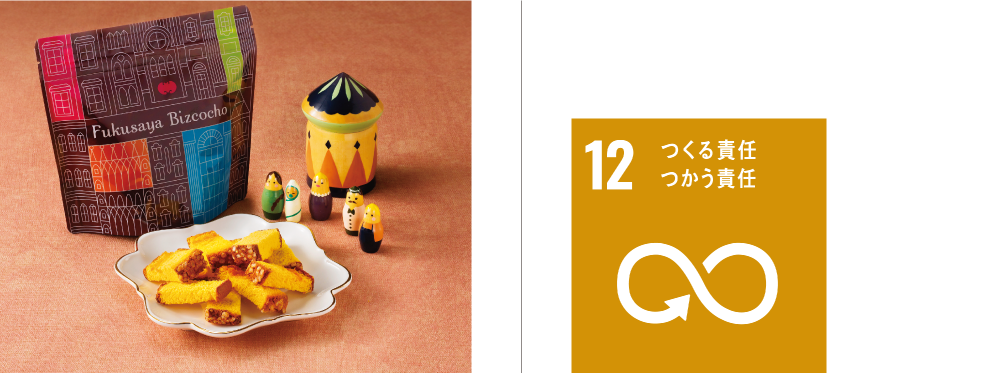
Tozaki: You're contributing to reducing food waste, aligning with SDG Goal 12: Responsible Consumption and Production. What made you focus on food waste?
Tonomura: We were originally concerned about discarding the scraps generated during the castella manufacturing process. We had periods where we distributed them to senior care facilities or gave them to employees, but compliance requirements eventually made disposal unavoidable.
Fukusaya's castella has been made by hand since our founding in 1624, so every edge reflects the craftsman's dedication. While respecting our artisans, I kept wondering if there was a way to turn these discarded edges into a product. Then, in 2017, my daughter, who was in high school at the time, learned about global food loss issues in a class. That sparked me to start thinking concretely: "What can Fukusaya do to solve this problem?"
Togisaki: So the conversation with your daughter was the catalyst!
Tonomura: This was just as people in Fukuoka city started wearing SDGs pins. We then called every food bank scattered across Fukuoka Prefecture. We listened to what activities they were currently doing and what challenges they faced, exploring what Fukusaya could contribute. That's how we conceived "Bizcocho."
Simply baking the scraps and calling them "rusks" wouldn't have been novel, so we sought a unique concept befitting a long-established castella maker. Bizcocho (bizcocho) is actually considered the root of castella in Spain, where castella originated. "Biz" means "twice" and "cocho" means "to cook," signifying a twice-baked food.
Tozaki: So it became a product that contributes to the SDGs, is uniquely achievable because it's castella, and also traces back to a long history.
Tonomura: As Fukuya approached its 400th anniversary, we wanted to create an initiative that would give back to society, expressing our gratitude for being able to continue our business for so long.
Adding a "concept" to products to convey the company's vision
Tozaki: The Biscocho initiative beautifully aligns your business with SDG contributions. However, many companies hesitate with SDG efforts due to concerns like "Will it generate revenue?" What strategies did Fukusaya employ to make this viable as a business?
Tonomura: There's a perception that SDGs are "volunteer work," and discussing "profit" carries negative connotations. However, considering corporate sustainability and employee labor, securing revenue is essential. So, instead of simply selling discarded parts at low prices, we added value by incorporating one or two extra steps into the product. Furthermore, we added the concept of donating to food banks, creating a dual meaning around "food loss" and "supporting food banks." By clearly communicating this, we aimed to create something customers could empathize with. We had never launched a product with such a "concept" before, so it was a completely new initiative. If we had just packaged it and sold it without explaining anything, it probably wouldn't have sold.
Tozaki: So "communicating" also expanded the business's potential.
Tonomura: Actually, Fukusaya has traditionally been a company that deliberately avoided promotion even when launching new products. But with this Biscocho, we truly realized that when you're doing something good, taking action to make people aware is also important.
Tozaki: Why do you think many Japanese companies believe in "not saying anything even when doing good things" or "there's no need to say it"?
Tonomura: I think there's a culture where "not saying" is considered a virtue. While valuing humility is a distinctly Japanese trait, there's also the issue that if you don't say it, people won't know about it, and it won't continue. We're currently learning that there are actually many good ways to communicate effectively.
Inspired by questions from children we met during the project,
Initiating efforts toward a "Circular Economy"
Tozaki: While you were realizing the importance of "communicating," you also decided to participate in this project with the slogan "Let's Create the Future." Were there other deciding factors?
Tonomura: I decided immediately upon hearing this project was happening in Fukuoka. The reason was the concept of "Future Leaders" (local children) coming for interviews. While opinions from various people are valuable for companies, opportunities to hear children's perspectives are rare. In an era overflowing with diverse sweets, how do children perceive castella? Precisely because it's a safe and reliable sweet, I wanted children to know about it. Being able to have direct dialogue was incredibly valuable.
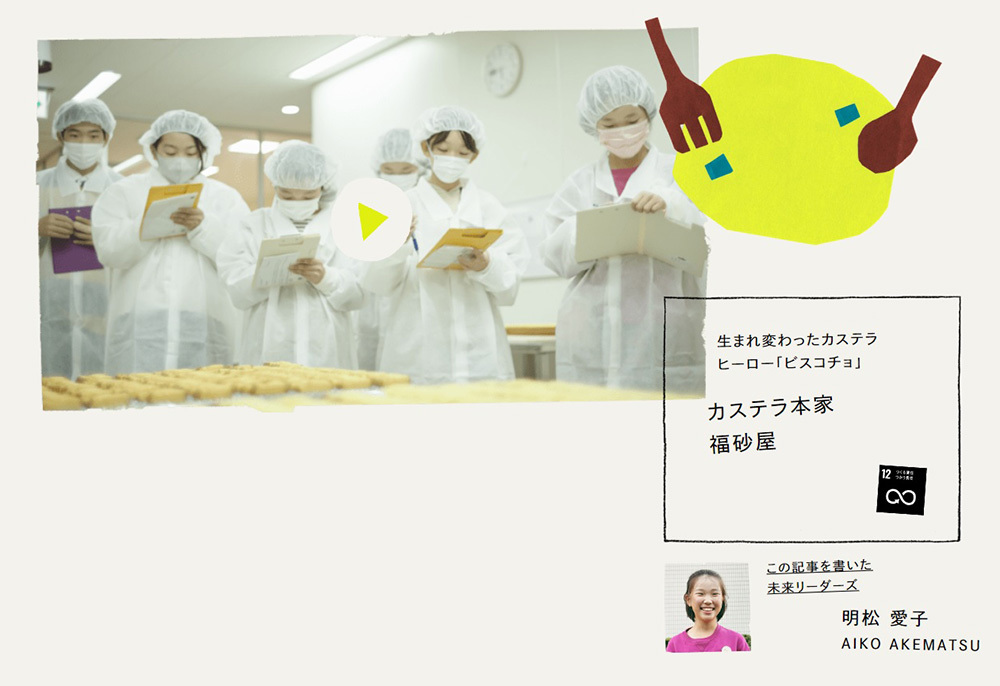
Tozaki: The Future Leaders visited Fukusaya, toured the factory, interviewed your staff, and their articles became newspaper ads. What was it like actually conversing with local children and seeing their work?
Tonomura: Adults tend to use complicated language, but since they were interviewing children, the Vice President and Factory Manager who were interviewed thought carefully about how to explain things clearly and prepared for it. They were unusually nervous (laughs). The children's opinions were direct, sprinkled with unique phrases that made you think, "Adults don't see things this way." It was refreshing. Children's real voices are a treasure for companies.
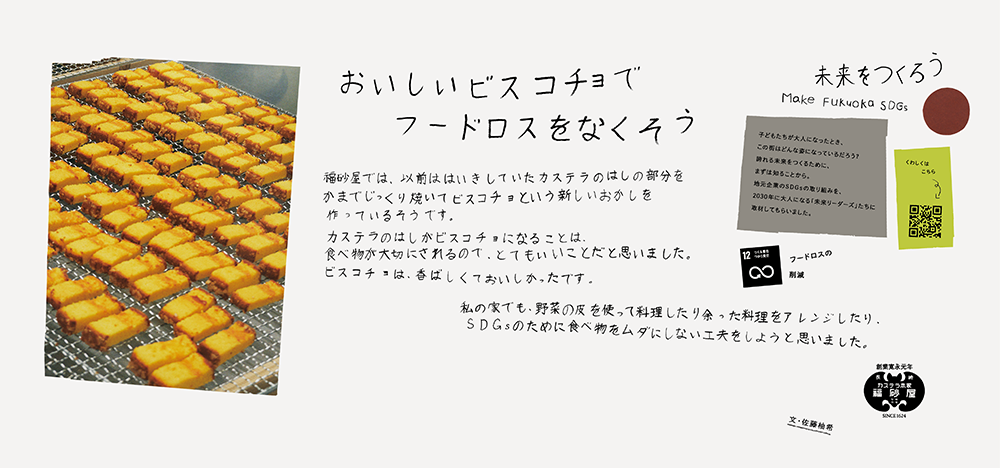
Tozaki: It was also impressive seeing the Future Leaders happily sampling Biscocho. I believe these foundational experiences for local children will stay with them even as adults. Since participating in the "Let's Create the Future" project, has your company seen any changes?

Tonomura: Actually, since we use a lot of eggs in making castella, we also end up with a huge amount of discarded eggshells. We'd been thinking about how to use these shells for something, and then one of the Future Leaders who came for the interview asked, "Have you considered recycling the eggshells?" That's what got us moving on this now.
Tozaki: What? So the Future Leaders' question was the catalyst?
Tonomura: I'd been troubled by the eggshells for a long time but hadn't acted. However, I didn't want to break the promise I made to the children during this project—that we would definitely work on recycling—so I started taking concrete steps.
We're recycling eggshells and using the resulting compost to grow tea. Fukusaya also makes castella using first-harvest tea leaves, so we're taking steps toward a "circular society" by growing tea with the eggshells from castella production. Our dialogue with them has reinforced our desire to remain a company that doesn't betray children, which also fuels our motivation.
Tozaki: So even more wonderful initiatives are emerging. If there's anything you'd like to see from the "Let's Create the Future" project going forward, please let us know.
Tonomura: Opportunities for cross-industry exchange are rare, so we'd be delighted to have spaces for exchanging opinions or even casual chats with participating companies, whether online or in person. Our eggshell composting initiative actually originated from a casual conversation with a tea farmer who mentioned, "Eggshells are ideal for tea cultivation." Such exchange spaces are crucial for gaining valuable insights.
Tozaki: Thank you for sharing your valuable insights. It reaffirmed my desire to create opportunities for companies to connect and support communication from an objective standpoint.
Was this article helpful?
Newsletter registration is here
We select and publish important news every day
For inquiries about this article
Back Numbers
Author

Takayuki Kamei
Superbrian Co., Ltd.
Executive Director
Joined Superbriant in 2011. After handling various duties, assumed responsibility for marketing in 2018. Positioned as a hub connecting society and business, aiming to realize sustainability for both.

Yumiko Tonemura
Fukusaya Co., Ltd.
Director, Planning Office
Leveraging experience from working at an advertising agency, he handles product packaging design and public relations. Since 2019, he has also initiated overseas strategies, launching full-scale international sales. Additionally, he actively pursues new ventures such as sports projects and SDGs initiatives.

Ikumi Toga
Dentsu Inc.
Second CR Planning Bureau
Copywriter/Planner
Creative direction and copywriting form the core of my work, which also encompasses branding, business development support from a creative perspective, communication development, product development, and project management. Served as Representative of Dentsu Inc. Gal Lab from 2016 to 2020.
